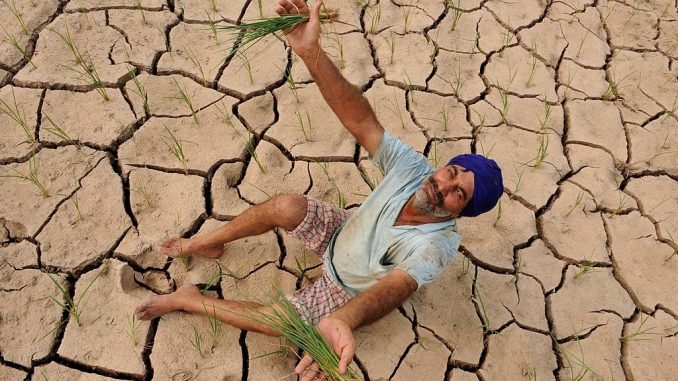
In last few years, people from newly set-up industries have come up with the idea of using aerial/autonomous vehicles for precision agriculture in India.
Precision agriculture, one of the modern farming practices, makes production more efficient by reducing misapplication of products and enabling growers to take large fields and manage them by dividing them into smaller areas. Precision agriculture also depends on information technology to ensure that the crops and soil receive exactly what they need for optimum health and productivity. It is often known as satellite agriculture, as-needed farming and site-specific crop management (SSCM).
However, in India, the primary challenge is not the technology but the system of farming. Despite the availability of open source technology and skill in the country to develop solutions, Precision farming is not being done in India.
If you look at the Indian agriculture scenario, there is over 150 million hectares of agricultural land and more than 118 millions of farmers in India. In last 40 years, farm lands have shrunk just a little, while the number of farmers has just doubled. The breakdown of the operational holding of land average per farmers gives clear idea that why the situation is becoming difficult.
As per Agricultural Census of 2010–11, the total number of operational holdings (individual farmers) was estimated to be 138.35 million and the total operated area was 159.59 million hectare. The average size of the holding was estimated to be 1.15 hectare. It meant that one farmer has an average of 1.15 hectare of land to grow crops.
Marginal Holdings: Below 1 Hectare
Medium Holdings: 4 to 10 Hectares
Large Holdings: 10 Hectares or more
The percentage of marginal holdings in 2010–11 was 67.1%.
Except the marginal holdings, the percentage of all other holdings has gone down in the last 20 years. The percentage of large holdings was found to be 0.7% in 2010–11. The percentage of medium holdings was 4.3% in 2010–11.
People who own large holding of land often live away in cities to have access to better standards of life and education. Of the remaining population, a majority of people belonging to the Other Backwards Castes (OBC) and higher caste identify themselves as self-employed (in agriculture). The largest chunk of Schedule Caste households in rural areas are engaged in farming as wage labours or salaried employees. This division and disconnect in aggregating agriculture land have now become a pressing problem for India.
Let me make myself clearer. Aggregating a 50-square hectare land owned by 50 different farmers is a big challenge.

In the last two decades, the government has attempted to aggregate land through various schemes. Several private firms have also tried to aggregate the farmland by doling out various offers on farming equipment. However, while the government failed miserably, the private companies went bankrupt and were forced to shut shop.
I remember, when I was a kid, a Hariyali Kisan Bazar was set up near my native village. The Kisaan Bazaar was supposed to be a chain of more than 300 stores spread across eight states – from Uttar Pradesh and Punjab in the north to Andhra Pradesh in the south. The bazaar represented a retail revolution in rural India by understanding and supplying farming families with all their agricultural and household needs.
The bazaar also weeded out middle-men from the system and connected the farmers directly to the big vendors. The concept of Hariyali Kisan Bazar grew from an agricultural extension program of DCM Shriram Consolidated Ltd (DSCL), a well-known Indian conglomerate producing fertiliser, seed and sugar, in 2002-03. The experiment of Hariyali Kisan Bazar failed after setting up 70 outlets across rural India. It suffered huge losses but was considered partially successful in creating a supply chain for the fertilisers, seeds, and farming equipment which could be a common point to aggregate the farmers.
The future of agriculture in India depends on small and medium farmers. The farmers with large landholdings constitute only 1.5% of the total population and contribute to around 35% of the food grain production. Thus, it is important to understand the role of these experiments and how they can help small and medium farmers in getting modern equipment, technology, techniques to increase agricultural yield.
The big farmers are known to have a clear commercial focus; they have limited credit means, makes their own brand choices and are leaders in new technology practices. But the small and medium farmers need credits, they are unable to adopt modern technology and are heavily influenced by the dealers. All this leads to sub-optimal quality of yield.
In fact, small and medium farmers produce for their families and a small proportion of crop yield is left for the market which is supplied by multiple agents from the village to the Mandi giving the farmers a minuscule part of the value of the product. This segment can only be successful if the costs of production are lowered. This will help the farmers get better price value and also help them in selling their output directly to the processors or the final consumers.
Since the operating cost of aerial or terrestrial equipment for precision agriculture on a few acres is high for both the farmer and the operator, aggregating the farming land is the only solution.
An uncertain economic environment with fluctuating low rural income and a high cost of production pose a great challenge to the experiments that can bring revolution in the agricultural sector in the country. In the past, experiments like Hariyali Kisan Bazaar and Mahindra Subhlabh Ltd have died a natural death.
Since they have been operating within their own sphere of influence, they have failed to create or scale up economies that are essential for the success of such experiments.
Indian agriculture is still dependent on technologies developed a hundred year ago. Modernisation and a major overhaul of the sector are the need of the hour.
Source: Youth Ki Awaaz

Leave a Reply